日本と同じ島国・英国における海洋エネルギー開発利用(各論: その2)
日本と同じ島国である英国の海洋エネルギー開発利用について概察したい。出典:英国プリモス国立水族館
1. ラ・ランス潮汐発電所 (フランス)
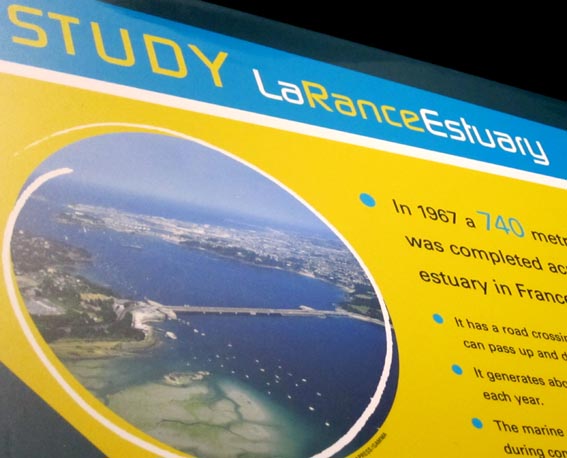 拡大画像
拡大画像
英国のプリモスは、英国南西部のコーンウォル半島にあって、イギリス海峡の西側海域に面し、かつて数多くの歴史的航海の起点となった
港町である。そのプリモスの国立海洋水族館 National Marine Aquriumにおいて、
海洋エネルギー発電に関して大変分かりやすいパネル展示がなされていた。
画像はフランスのラ・ランス河口域に建設された、潮のせき止め堰(バラージ barrage)タイプ、あるいは潮受け堰タイプの
潮汐発電所である。
画像の中央に見えるのが、自然の河口域の両岸に渡された、潮を堰き止めるための堰である。堰の一部には水の出入り口があり、
又船舶の出入りができる閘門が造られている。上げ潮時に、外海の海水が堰の陸地側(貯水池側)に堰き止められる。
下げ潮時に、発電のため貯水池に溜まった海水がタービンを通って外海へ排出される、という潮汐利用の発電施設である。
国立海洋水族館の展示パネルには次のようなキャプションが記されている。
ケース・スタディ (事例研究):ラ・ランス河口域
1967年に、ラ・ランス河口域の両岸に渡された長さ740mの堰(バラージ)が完成した。
・ バラージには道路が通じており、またロック(閘門)が築造されているので、船舶はそのバラージを上り下りできる。
・ 毎年、480GWh (ギガワット時) の電気を発電する。
・ 建設期間中は海洋エコシステムをひどく悪化させた。河口域の流れが少なくなるにつて、水は淀むようになった。
・ 現在ではエコシステムは回復されているが、オリジナルのエコシステムから生じてきたいろいろな変化をモニターするための
適切な研究が実施されることはなかった。
Case Study: La Rance Estuary
In 1967 a 740 metre long barrage was completed across La Rance estuary in France.
> It has a road crossing and locks so that ships can pass up and down.
> It generates about 480 GWh of electricity each year.
> The marine ecosystem was badly damaged during construction. With the flow reduced water became stagnant.
> Though the ecosystem is now restored no proper studies were carried out to monitor any changes that have taken place from
the original ecosystem.
[画像撮影 2013.5.29/英国・プリモス国立海洋水族館][拡大画像: x25691.jpg]
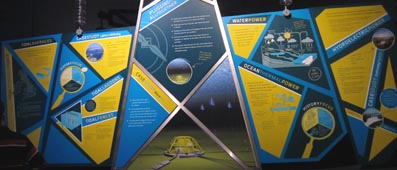
パネルでは、水力発電、温度差発電(OTEC)、ラ・ランス潮汐発電所の他、各種の潮汐発電について説明している。
[拡大画像: x25852.jpg]
2. 温度差発電 (OTEC) について [構造図]
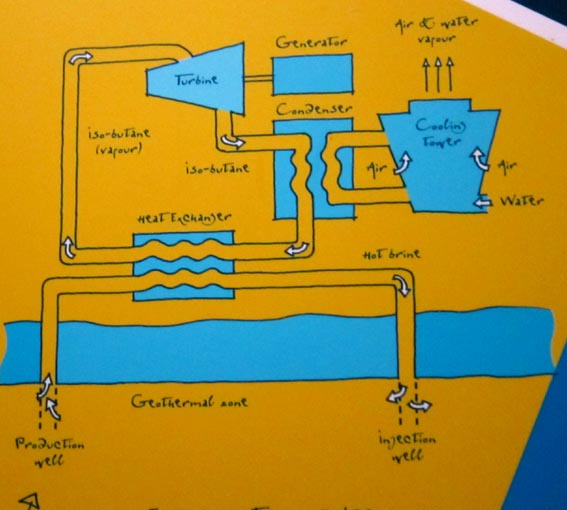 拡大画像
拡大画像
英国の港町プリモスは、英国南西部のコーンウォル半島にあって、イギリス海峡の西側海域に面する。プリモスは数多くの歴史的
航海の起点となった港町でもある。そのプリモスの国立海洋水族館
National Marine Aqurium, Plymouth, UKにおいて、英国&海洋エネルギー発電に関する大変分かりやすいパネル展示がなされていた。
画像は海洋の熱(温度)利用による発電(温度差利用による発電)について説明するために掲示された「オーガニック・ランキン・
サイクルエンジン」図である。
その説明パネルには次のようなキャプションが記されている。
海洋の熱(温度)のパワー (→ 温度差利用による発電)
・ 海洋温度差発電は表層の暖かい水と深層の冷たい水の温度差を利用する。
・ 熱帯域の表層水は摂氏25度に達しうる一方、深層水は大変冷たく摂氏5度で、その差は20度である。
・ 暖水・冷水はオーガニック・ランキン・サイクル・エンジン(Organic Rankine Cycle Engine)と呼ばれる特別の
タービン内でのブタンガスを沸騰させ凝縮させるのに用いられる。
* エンジン図の説明書き
・ 太平洋にて作動させるために実験がなされてきたが、工学的な困難性には大きなものがある。
・ システムを作動させるためには、莫大な量の冷水が1000mまたはそれ以上の水深からポンプアップされねばならない。
Ocean Thermal Power
> Ocean thermal power makes use of the temperature difference between the warm surface water and the cold deep water.
> Surface water in the tropics can reach a temperature of 25oC whilst the water in the depths
is very cold, about 5oC - a difference of 20oC.
> The hot and cold water is used to boil and condense butane gas in a special turbine called an
Organic Rankine Cycle Engine.
* diagram caption
> Experiments have been made to work in the Pacific Ocean but the engineering difficulties are very great.
> Huge amounts of cold water must be pumped from depths of 1000 metres or more to make the system work.
* diagram terms: iso-butane(vapour), turbine, generator, condenser, cooling tower, air and water vapour, heat exchanger,
hot brine, geothermal zone, production well, injection well.
[参考] Rankine Cycle: n.[理]ランキンサイクル[蒸気サイクルの一様式; 熱エネルギーを機械的仕事に変換する] W.J.M.ランキンは
英国スコットランドの技師・物理学者.
[画像撮影 2013.5.29/プリモス国立海洋水族館][拡大画像: x25690.jpg][拡大画像: x25860.jpg: 説明書き]

パネルでは、水力発電、温度差発電 (OTEC)、ラ・ランス潮汐発電所の他、各種の潮汐発電について説明している。 [拡大画像: x25852.jpg]
3. 潮汐発電について [月の引力&潮の満ち引き図]
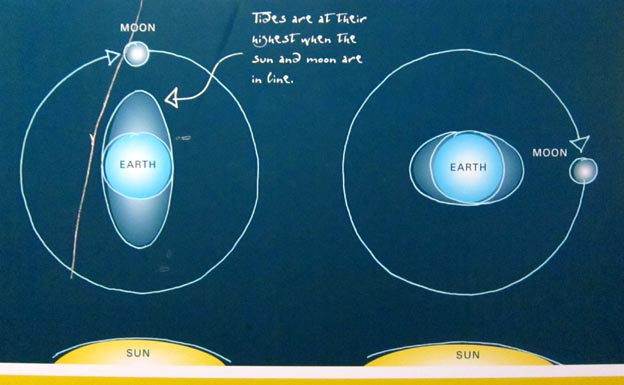 拡大画像
拡大画像
模式図には「太陽と月が一直線に並ぶ時、潮は最も高くなる」( "Tides are at their highest when the sun and moon are in line.") と
記されている。
英国の港町プリモスは、英国南西部のコーンウォル半島にあって、イギリス海峡の西側海域に面する。プリモスは数多くの
歴史的航海の起点となった港町でもある。そのプリモスの国立海洋水族館
National Marine Aqurium, Plymouth, UKにおいて、英国&海洋エネルギー発電に関して大変分かりやすいパネル展示がなされていた。
潮汐や潮流のもつパワー(潮力tidal power) とは、第一義的に月の引力に起因する海水の水平移動による力である。
展示では、海水の水平移動時における流れや、その水平移動によって集積された海水の蓄積された位置エネルギーを電気に変換する、
いろいろな発電方式を説明する。
また、海水の水平移動を引き起こす自然原理などを説明する。画像は太陽・地球・月の位置関係と潮の満ち干 (大潮・小潮) などを
模式図にしたものである。説明パネル (一部英文のまま) には次のように記されている。
Tidal Power
> Tidal power comes from the pull of the moon on the oceans of the Earth.
The moon's gravitational pull draws the seas on the side of the Earth nearest the moon towards the moon.
> This regular rise and fall of the sea can be used to generate power.
We call the rising tide the flood and the falling tide the ebb.
> Tidal power makes use of a very simple technique. A pool is topped up at high tide
and the water trapped. As the water drains outat low tide it drives turbines or machinery to generate power.
> A tidal range of at least 5 metres is best for power generation.
潮汐と時間
・ 潮汐はさまざまな場所や日ごとに変化する。
・ 月は24.8時間ごとに地球を周回する。我々の1日は24時間であり、潮汐は満ち干(上がり下がり、干満)につれて遅くなっていく。
・ 潮の満ち干の時刻を知ることは、仕事やレジャーのために海を利用する人にとって大変重要なことである。
Tides and Time
> Tides vary at different locations and from day to day.
> The moon takes 24.8 hours to orbit the Earth. As our day is only 24 hours long the tides get later with each rise and fall.
> Knowing the time of high and low tide is very important to anyone who uses the sea for work or pleasure.
潮位差(潮差、満ち干の差、潮の干満差)
・ 大西洋の真ん中では、潮はわずかに0.5mほど上昇する。しかし大西洋の端っこでは海底は盛り上がっており、その干満差
(潮位差)はおよそ3mに増大する。
・ 沿岸では、海水は河口域や小湾に向けて漏斗状に寄せ集められ、その水嵩が増大していく。
これは更に大きな満ち干を作り出す。セヴァーン河口域の海水寄せ集め効果は、11メートル以上の潮位差を作り出す。
・ 太陽と月が一直線上に並ぶと潮汐はより大きくなる。これはスプリング・タイド(大潮)と呼ばれる。大潮は一年中生じる。
・ カナダのファンディ湾では、世界で最も大きな満ち潮が引き起こされる。潮位差は16.3mにも及ぶ。
Tidal Range
> In the middle of the Atlantic Ocean the tide only rises about 0.5 metres - whereas at the edge of the Atlantic
Ocean the sea bed rises and increases the tidal range to about 3 metres.
> Around the coast the water is funnelled into estuaries and inlets.
This can create an even bigger rise and fall. The funnelling effect of the Severn Estuary can produce tides of 11
metres or more!
> When the sun and moon are in line the tides are even higher. These are called spring tides.
Spring tides happen throughout the year.
> The highest tides in the world are in the Bay of Fundy, Canada. The difference between high and low tide is 16.3 metres.
[画像撮影 2013.5.29/英国・プリモス国立水族館にて][拡大画像: x25816.jpg]
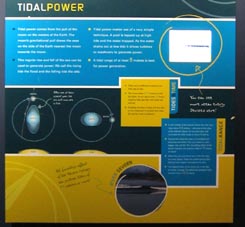 [拡大画像: x25861.jpg]
[拡大画像: x25861.jpg]
* キャプション→ River Severn: The funnelling effect of the Severn Estuary can produce tides of 11 metres or more!
* 説明書き [拡大画像: x25862.jpg: Tidal Power][拡大画像: x25863.jpg: Tides and Time][拡大画像: x25864.jpg: Tidal Range]
英国セヴァーン河口域での潮汐発電について
英国セヴァーン河口域での潮汐発電は、フランスのラ・ランス河口域と同じ原理で、バラージ (barrage) をもって海水を堰き
止めるものである。
展示パネルでは、セヴァーン川*の河口域における、潮汐作用による海水の寄せ集め効果 (funnelling effect;
河口域の狭隘化による海水の集積効果; 海水が漏斗状に狭隘化した水域に流れ押しこめられ、水嵩が増大していく効果)について
説明している。: 海水が潮汐により河口域や入り江の陸地側に向けて漏斗状に流れて寄せ集められて行くという効果によって、
ずっと大きな干満差(潮汐差)が作り出されることになる。因みに、セヴァーン川河口域では、この効果によって11m以上の
潮位差が作り出される。
* セヴァーン川 River Severn: 英国ウェールズ地方を南下し、セヴァーン河口 Mouth of Severn に流れ出て、さらにブリストル湾
Bristol Channel へと流れ行く。ブリストル湾にはブリストル Bristol やカーディフ Cardiff などの大都市が面している。
4. バラージ築造 (築堰) 式潮汐発電について
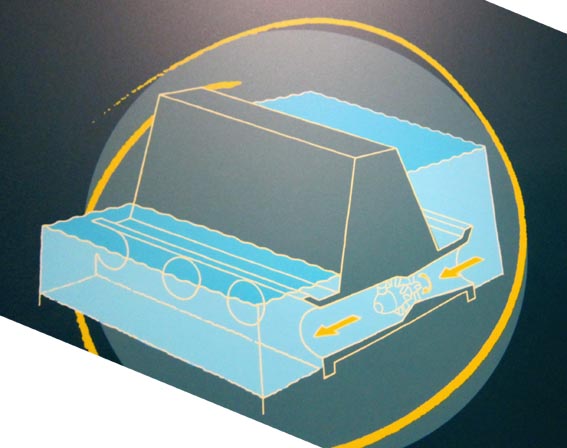 拡大画像
拡大画像
英国の港町プリモスは、英国南西部のコーンウォル半島にあって、イギリス海峡の西側海域に面する。プリモスはこれまで
数多くの歴史的航海の起点となった港町でもある。そのプリモスの国立
海洋水族館 National Marine Aquriumにおいて、英国&海洋エネルギー発電に関して大変分かりやすいパネル展示がなされていた。
潮汐・潮流発電には起電方式がいろいろあるが、そのうちの一つがこのバラージ築造式である。
河口域などに人工的にバラージを築堤し、上げ潮(満ち潮)で岸に向けて流れて来る (水平移動して来る) 潮流を堰き止めた後、下げ潮
(引き潮) 時にそのバラージの陸側に貯水された海水を沖に向けて排水する。その時バラージの下部に設置された水車を回転させ発電する
というものである。
画像はこのバラージ築造 (築堰) 式の潮汐利用発電を模式化したものである。説明パネルには次のように記されている。
タイダル・バラージ (潮汐を利用するバラージ、潮の満ち引き利用バラージ)
潮が満ちてくるとバラージを海水が流れ通り、その後スルースゲートが閉じられて海水がトラップされる(堰き止められる)。
・ 引き潮時にはその堰き止められた海水はタービンを通って放出され、発電される。
・ 英国では、このタイダル・バラージ築造に適するいくつかの河口域がある。
・ タイダル・バラージは大変コストがかかるが、莫大な量の電力を起こすことができる。
Tidal Barrages
A tidal barrage allows water to flow through as the tide rises and then traps the water by closing sluice gates.
> At low tide the trapped water is released through turbines to generate electricity.
> In the UK there are several estuaries that are suitable for tidal barrages.
> Tidal barrages are very expensive to build but they can generate huge quantities of electric power.
模式図キャプション: "Water is released through turbines to generate electricity."
タイダル・バラージ・パワー(潮汐を利用するバラージ築造 (築堰) 式発電、潮の満ち引き利用のバラージ発電)
・ 英国の理論上の潮汐利用の総発電量は年間53TWh(テラワット時)である。これは2002年における発電量の14%に相当する。
Tidal Barrage Power
> The total theoretical amount of UK tidal power is estimated to be 53 TWh per year.
This is about 14% of the electricity generated in the UK in 2002.
潮汐バラージには3つのタイプがある。それらは全て海水の流れを利用して発電する。
1. 海水は満潮時に人工バリア (障壁物) 背後の陸側にトラップされる (堰き止められる)。せき止められた水が海へ流し戻される際に、
海水がタービンを通ることで発電する。これは「引き潮時発電 (エブ発電)」と称される。
2. いくつかのバラージは満ち潮を利用して発電する。これは「満ち潮発電 (フラッド発電)」と呼ばれる。
3. フラッド発電およびウェブ発電は、潮の満ち干に合わせ24.8時間ごとに2回の集中的発電をもたらす。
これはより平準化された電力を供給することになる。
> There are 3 basic types of tidal barrages. They all generate power using the flow of sea water.
1. Sea water is trapped behind an artificial barrier at high tide. As the trapped water flows back to the sea
it passes through turbines and generates electricity. This is called ebb generation.
2. Some barrages use the rising tide to generate power. This is called flood generation.
3. Ebb and flood generation produce two bursts of power every 24.8 hours as the tide rise and fall.
This provides a more even supply of power.
1 2
2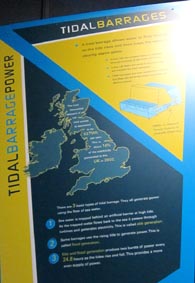
1. パネル全体図。 [拡大画像: x25852.jpg]
2. バラージ築造式潮汐発電の説明パネル。 [拡大画像: x25853.jpg][拡大画像: x25856.jpg:英国図]
[拡大画像: x25854.jpg][拡大画像: x25857.jpg]
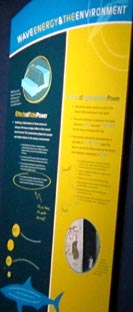
波エネルギーと環境 Wave Energy and The Environment
潮力の効果 Effects of Tidal Power
・ 河口域にバラージあるいはフェンス(柵)を築造することは自然環境に大きな影響を及ぼすであろう。プロジェクトの建設局面では、
河口域の環境に負の影響をもたらしうる。
・ もし河口域において潮の流れが減じられれば、重大な環境問題が発生するにいたる。海水が淀むようになり、河口域を利用する
野生生物にとって大変悪いことになる。
・ タイダル・バラージがいったん完成されれば、現実にはタイダル・バラージは水質にポジティブな効果をもつかもしれない。
・ バラージなどの建設によるそれらの変化がより良いものに、あるいはより悪いものに変わるかどうかを実際的に予測することは
大変困難である。どんな変化が起ころうとも、環境への変化はさけられそうにない。
> Building a tidal barrier or fence across an estuary will have a major effect on the natural environment.
The construction phase of a project can badly impact on the estuary environment.
> If the tidal flow of an estuary is reduced serious environmental problems can occur.
Water can become stagnant wihch is very bad for the wildlife that uses the estuary.
> The amount of salt in the water behind the barrier can re reduced. This will effect the creatures that live there.
> Once completed a tidal barrier may actually have a positive effect on the water quality. This might
allow new species of wildlife to thrive.
> It is very hard to acurately predict whether the changes will turn out for the better
or for worse. Whatever happens there will be changes to the environment.
[拡大画像: x25820.jpg][拡大画像: x25872.jpg][拡大画像: x25873.jpg]
* captions
47% of European geese visit UK tidal estuaries.
28% of European swans and ducks visit UK tidal estuaries.
At the Annapolis Royal tidal barrier in Canada, fish were being killed in the turbines.
Fish are now warned to stay away by a loud underwater thumping sound.
Tidal lagoons are thought to be much less damaging to the environment than tidal barriers.
[画像撮影 2013.5.29/英国プリモス国立海洋水族館にて][拡大画像: x25694.jpg]
5. 人工ラグーン (人工潟) 造成式 とフェンス築造式による潮汐発電ついて
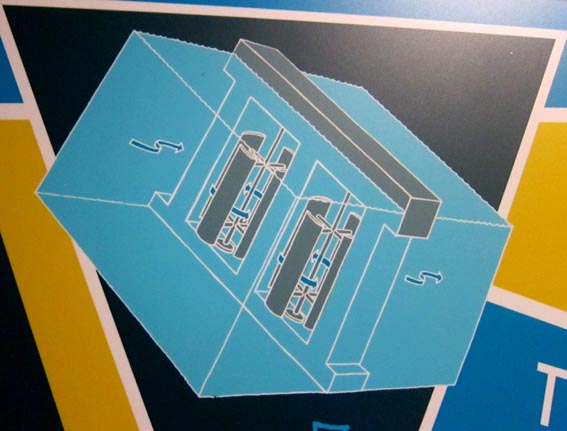 拡大画像
拡大画像
英国の港町プリモスは、英国南西部のコーンウォル半島にあって、イギリス海峡の西側海域に面する。プリモスは数多くの
歴史的航海の起点となった港町でもある。そのプリモスの国立海洋水族館
National Marine Aquriumにおいて、海洋エネルギー発電に関して大変分かりやすいパネル展示がなされていた。
潮汐・潮流を利用した発電方式にはいろいろある。堰を築造して特定の海域を囲い込み、人工的にラグーンを外海に向けて
造成する方式がある。
上げ潮時には、その人工ラグーンに海水を導き入れた頃合いに堰き止め、海水で満す。
下げ潮時には、ラグーンから外海に向けて海水を排水する。その排水時にその人工堰の下部に設けられた水車を回転させ発電する。
翻って、人工堰を築造し水域を囲い込むのではなく、潮の行き来する海域にフェンスを設ける方式がある。画像はそのフェンス式
(築柵式)の潮汐・潮流利用発電の模式図である。
フェンスの陸側に海水がトラップ(堰き止め)されるものではなく、潮の満ち引に応じて水平移動する海水の流れ、即ち潮流が
海面下に横列状に設置された複数のタービンを行き来することで、ローター・発電機を回転させ起電する。
人工ラグーン造成式発電は前ページに既述の 「バラージ築造による潮汐発電」 と基本的には
同じ方式であるが、その違いはバラージの築堤方法にあるといえる。説明パネルには、人工ラグーン造成式とフェンス
築造式潮汐発電について次のように記されている。
人工造成ラグーン (人工潟) 式による潮汐利用発電
・ タイダル・ラグーンは、天然の河口域を利用するものではない。人工的な河口域またはラグーンが海に向けて造られる。
・ ラグーンは上げ潮時に海水で満たされる。それが排水される時にタービンを作動させ発電する。
・ 仮に幾つかのラグーンが一度に一つずつ排水されると、コンスタントな出力が作り出される。
・ 423MWのタイダル・ラグーンが北ウェールズ海岸沖のライル*に計画されている。ラグーンの貯水池は長さ14㎞、
幅3kmとされる。池は幾つかのセグメントに区切られ、それらから一度に一つずつ排水されることで、ほとんど連続して発電する
ことができる。
* ライル(地名): リバプールの西方数10km; リバプール湾に面する。
A 423 MW tidal lagoon is planned at Rhyl off the North Wales coast. The lagoon reservoir will be 14 km long and 3 km wide.
It is divided into segments which can be drained one at a time to provide almost continous power.
フェンス式による潮汐利用発電(タイダル・フェンス式)
・ タイダル・フェンス (潮汐を利用するフェンス式発電) は、タイダル・バリア (潮汐を利用するバリア式発電、防潮壁式発電) とは違う。
・ タイダル・フェンスの場合は、海水はそのフェンスの陸側でトラップされる(堰き止められる)ことはない。その代り、
海水は海面下に一列状に設置された複数のタービン内を流れることになる。
・ フェンスは場合、建設期間中は野生生物にダメージをもたらし続けることにはなるが、ごくわずかな環境問題である。
* 海水は海面下の一列に並ぶタービン内を流れる。
[画像撮影 2013.5.29/英国・プリモス国立海洋水族館][拡大画像: x25819.jpg]
* 説明書き [拡大画像: x25858.jpg: Tidal Lagoons][拡大画像: x25859.jpg: Tidal Fences]
 [拡大画像: x25852.jpg]
[拡大画像: x25852.jpg]
6. 潮流発電装置 ⌈シーフロー (Seaflow) ⌋
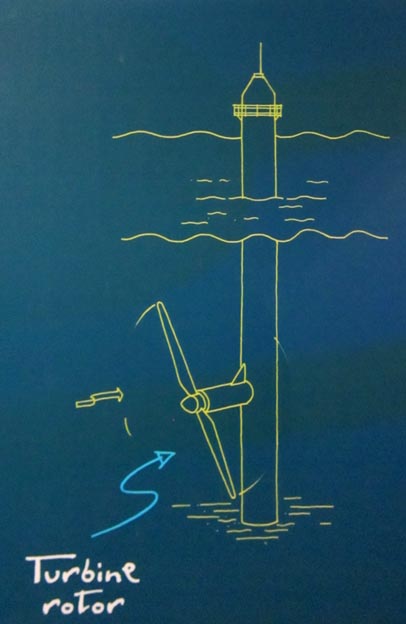 拡大画像
拡大画像
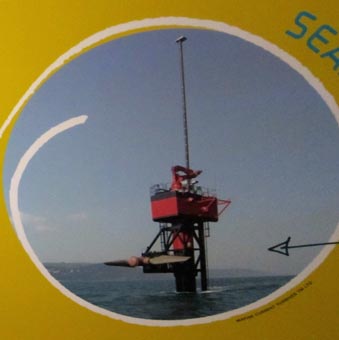 拡大画像
拡大画像
英国の港町プリモスは、英国南西部のコーンウォル半島にあって、イギリス海峡の西側海域に面する。プリモスはかつて数多く
の歴史的航海の起点となった港町でもある。そのプリモスの国立海洋水族館
において、海洋エネルギー発電に関する大変分かりやすいパネル展示がなされていた。
画像は、英国デヴォン (Devon) 州北岸沖で初めて試験された潮流発電装置⌈シーフロー (Seaflow) ⌋をイメージした模式図
および海中から引き揚げられた⌈シーフロー⌋のローターである。説明パネルには次のように記されている。
潮流のもつ力
・ 速く流れる潮流 (tidal currents) のもつエネルギーを海中タービンをもって有用なパワーに変換することが出来る。
スコットランドの西岸やアイリッシュ海は潮流発電装置を設置するには好適の立地場所である。
・ 潮流発電タービンは風力発電タービンに大変似かよっている。前者のタービンは後者のタービンよりずっと遅く回転する。
だが、潮流においては、その水がもつずっと大きな力ゆえ、より多くの電気を発電する。
・ タービンは海底に固定される、あるいは固定された浮体式プラットフォームに鎖で繫ぎ止められる (be tethered)。タービンは、
潮流の向きが変われば、それに合わせて自由に旋回する。海洋潮力利用計画が環境へもたらすインパクトは極めて低いものである。
Tidal Current Power
> The energy of fast flowing tidal currents can be converted to useful power using underwater turbines.
The west coast of Scotland and the Irish Sea are good locations for tidal current devices.
> Tidal current turbines are very similar to wind turbines.
They rotate much slower than wind turbines but they can generate a lot more power because of the greater force of the water.
> The turbines are fixed to the sea bed or tethered to fixed floating platforms.
They are free to rotate as the current changes direction.
> The environmental impact of ocean tidal power schemes is quite low.
・ 海水の温度差やその中の塩分度 (塩分濃度) の違いはまた海流を生み出す。
・ 潮が満ち干すると、潮は島嶼間の狭い水道に集中させられることになり、流れの速い潮流を生み出す。
・ 海洋のこれらの強い海流や潮流は潜在的エネルギー源である。
> Temperature differences and changes in salinity (salt content) of the water can also create ocean streams.
> As tides rise and fall they can be concentrated in narrow channels between islands to produce fast flowing tidal currents.
> These strong ocean streams and tidal currents are a potential source of energy.
潮流発電装置
・ ⌈シーフロー⌋(Seaflow)は、海中風力タービンのようなものである。
・ 電気を起こす大きな海中ローターを回転させるために潮流が利用される。
・ ⌈シーフロー⌋はデヴォン州の北岸沖で初めて試験された。
Tidal Current Devices
> Seaflow is rather like an underwater wind turbine.
> It uses tidal currents to drive a large underwater rotor which generates electricity.
> Seaflow was first tested off the north Devon coast.
⌈シーフロー⌋ - Marine Current Turbines TM LTD
・ タービンは海中で発電にいそしんでいるので、通常タービンを見ることができない。しかし、タービンの点検などのために
アクセスするに当たっては海中から引き揚げられる。
SEAFLOW - Marine Current Turbines TM LTD
> You can't usually see the turbines as they're busy generating electricity under the water - but
they can be raised for access - as shown here.
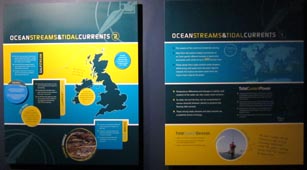 * パネル⌈Ocean Streams and Tidal Currents 1 & 2⌋: ⌈Tidal Current Power⌋⌈Tidal
Current Devices⌋について説明する。なお、画像の左パネルに記される説明文はこちらを参照ください
。 [拡大画像: x25884.jpg]
* パネル⌈Ocean Streams and Tidal Currents 1 & 2⌋: ⌈Tidal Current Power⌋⌈Tidal
Current Devices⌋について説明する。なお、画像の左パネルに記される説明文はこちらを参照ください
。 [拡大画像: x25884.jpg]
1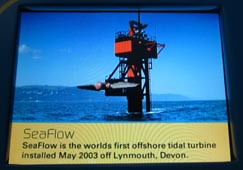 ・ 英国デヴォン州コーンウォル半島のリンマス (Lynmouth) にて、2003年5月、
世界初の沖合潮流タービン⌈シーフロー⌋が設置された。
・ 英国デヴォン州コーンウォル半島のリンマス (Lynmouth) にて、2003年5月、
世界初の沖合潮流タービン⌈シーフロー⌋が設置された。
> SeaFlow is the world's first offshore tidal turbine installed May 2003 off Lynmouth, Devon. [拡大画像: x25808.jpg]
* リンマス: 英国南西部コーンウォル半島の北岸の町で、ブリストル水道 (Bristol Channel) に面する。真向いの対岸にはスウォンジー
(Swansea) という大きな町がある。など、水道の奥にはブリストル (Bristol) やカーディフ (Cardiff) という大都市がある。
2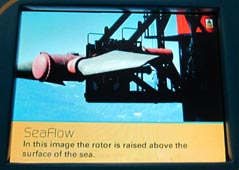 ・ ローターが海面上に引き揚げられたところ。
・ ローターが海面上に引き揚げられたところ。
> In this image the rotor is raised above the surface of the sea. [拡大画像: x25809.jpg]
3 ・ ローターが一たび海面下に降ろされると、潮流の力によってローターが回転し発電する。
・ ローターが一たび海面下に降ろされると、潮流の力によってローターが回転し発電する。
> Once the rotor is lowered below the surface, tidal power turns the rotor to generate power. [拡大画像: x25810.jpg]
[画像撮影 2013.5.29/英国・プリモス国立海洋水族館][拡大画像: x25688.jpg][拡大画像: x25689.jpg: Seaflow + tidal
current devices]
7. 世界の波力について [世界の波力エネルギーポテンシャル図]
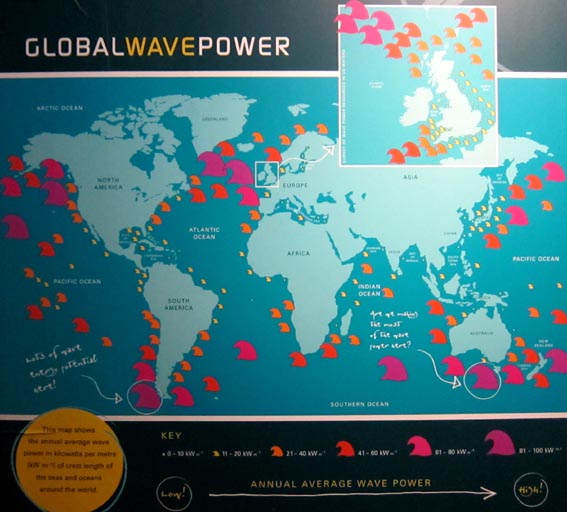 拡大画像
拡大画像
英国の港町プリモスは、英国南西部のコーンウォル半島にあって、イギリス海峡の西側海域に面する。プリモスはかつて
数多くの歴史的航海の起点となった港町でもある。そのプリモスの国立海洋
水族館 National Marine Aquriumにおいて、海洋エネルギー発電に関して大変分かりやすいパネル展示がなされていた。
画像の模式図は、「世界の波のエネルギー(Gobal Wave Power)」と題して、世界海洋における海域別の波力エネルギーの
ポテンシャルを示している。
特にポテンシャルが高いのは、北太平洋の北部海域(アラスカやカムチャッカ半島周辺など)、北大西洋の北部海域 (スペイン・英国辺り
からグリーンランド周辺にかけて)、南米大陸南部の両洋沿岸域、オーストラリア南部やニュージーランド周辺の海域などである。
島嶼国の日本やイギリス周辺海域でのポテンシャルがかなり高いことが示されている。
模式図は世界の海洋について、波長1メートルにつきでどれくらいの年間平均波力発電力 (annual average wave power) をもつかを
キロワット数で示したものである。
その凡例によれば、最も大きい波浪マークは81~100kWm-1、その下位のマークは61~80kWm-1のポテンシャル
をもつ (以下省略)。
> This map shows the annual average wave power in kilowatts per metre (kW m-1) of crest length
of the seas and oceans around the world.
KEY: 0-10 kWm-1, 11-20 kWm-1, 21-40kWm-1, 41-60kWm-1, 61~80kWm
-181~100kWm-1.
* 南米大陸最南端のホーン岬周辺では「Lot of wave energy potential here!」と示されている。
* 英国周辺海域での波エネルギーポテンシャルが拡大模式図(Survey of wave power resources in UK waters)として示されている。
[画像撮影 2013.5.29/英国・プリモス国立海洋水族館][拡大画像: x25807.jpg]
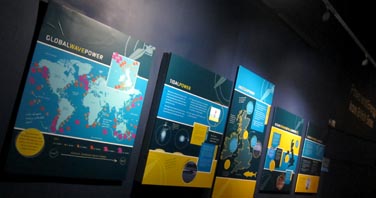 拡大画像 [拡大画像: x25865.jpg]
拡大画像 [拡大画像: x25865.jpg]
8. 半没水型でシリンダー形の浮体装置 (ヒンジ連結式)
「ペラミス(Pelamis)」 による波力発電について
Semi-submerged, cylinder-shaped floating wave power
generation device linked by hinged
joints "Pelamis"
1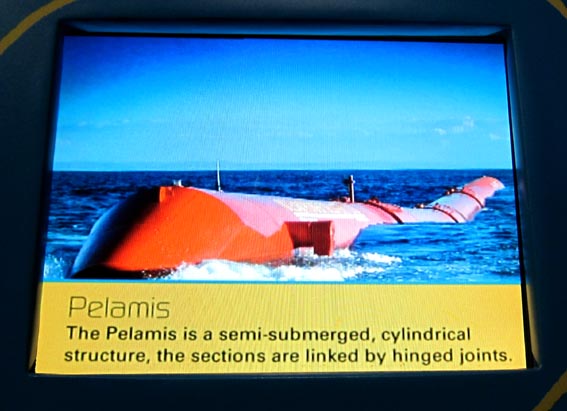 400
2
400
2 300
300
3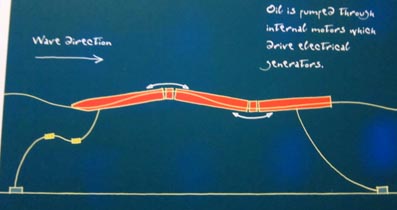
英国の港町プリモスは、英国南西部のコーンウォル半島にあって、イギリス海峡の西側海域に面する。プリモスはかつて
数多くの歴史的航海の起点となった港町でもある。そのプリモスの国立海洋
水族館において、海洋エネルギー発電に関して大変分かりやすいパネル展示がなされていた。
画像1および2は、英国で開発された、半没水式のシリンダー構造で、ヒンジで連結される浮体式の波力発電装置「ペラミス (Pelamis) 」である。
画像3の模式図では、その半没水式シリンダー構造をもつ浮体の連結や動態について示されている。説明パネルには次のように記される。
浮体装置
・ 「ペラミス波力エネルギー変換装置」、あるいは「シー・スネーク」は数多くの浮体式シリンダーでできている。
・ 「ペラミス」が波浪とともに上下動するにつれ、高圧力のオイルがシリンダー内部のモーターに勢いよく注入され発電機を駆動させる。
・ 実物大の「ペラミス」がオークニー (Orkney) のEMEC*の海域に設置されている。
キャプション: 波向。オイルがモーターに勢いよく注入され発電機を駆動させる。電力は、装置先端にあるトランスフォーマー (変圧器)
に繋がれているシングルの送電線を通じて海底 [の電気蓄積器など] へ送り込まれる (画像3の装置先端を参照)。
* EMEC: European Marine Energy Centre 欧州海洋エネルギーセンター
[所在:英国オークニー諸島]
Floating devices
> The Pelamis Wave Energy Converter, or 'sea snake' is made up of a number of large floating cylinders.
> As Pelamis moves up and down with the waves high-pressure oil is pumped through internal motors which drive electric generators.
> Full size Pelamis devices are installed in the sea at EMEC, Orkney.
Caption: Wave direction. Oil is pumped through internal motors which drive electrical generators.
Power is fed to the seabed via a single umbilical connected to a transformer in the nose of the device.
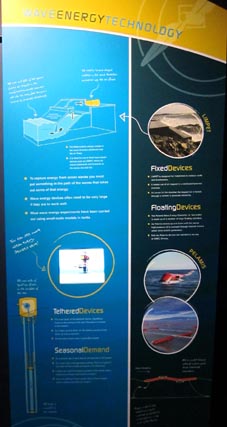 拡大画像
[拡大画像: x25818.jpg][画像: z19796.jpg]
拡大画像
[拡大画像: x25818.jpg][画像: z19796.jpg]
説明書き: [拡大画像: x25870.jpg: Floating Devices][拡大画像: x25871.jpg: caption]
波力利用について
・ 科学者が見積もるところによれば、英国の北部および西部の海岸線沿いの波力の平均的総量は、年間260TWh (テラワット時、
T=1012=1兆) に匹敵する。
2002年における英国の電力需要は350TWhである。
* 英国における波力利用の最適地のいくつかはスコットランドにある。
波力発電装置の「ペラミス」は近代的な風力発電タービンと同じくらいの出力をもつ。
・ 1平方㎞の海域に波力発電装置を設置することによって、2万世帯向けに電気を供給することができよう。
・ 「ペラミス」は半没水型で、シリンダー形の構造をもち、各発電ユニットはヒンジ・ジョイントによって連結される。
> Pelamis has a similar output to a modern wind turbine.
> A installation of a square kilometer of ocean could provide electricity for 20,000 homes.
> The Pelamis is a semi-submerged, cylindrical structure, the sections are linked by hinged joints.
・ 波によって引き起こされる動きは油圧式ラム (油圧装置のピストンなど) を突き動かし、それによってオイルが勢いよく
油圧モーターの中へ注入される。
・ 油圧モーターは発電機を駆動させ電気を起こす。
> The wave-induced motion is resisted by hydraulic rams, which pump oil through hydraulic motors.
> The hydraulic motors drive electrical generators to produce electricity.
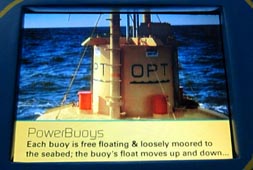 [拡大画像: x25895.jpg]
[拡大画像: x25895.jpg]
「パワーブイ PowerBuoys 」はインテリジェントなシステムで、さまざまな波の状態に対応することができる。
各ブイは自由自在に浮遊するが、海底にゆるやかに係留されている。ブイの浮体 (フロート) は上下に動き、、、、
「ウェーブ・ブイ」からのデータは波力エネルギー開発者に利用されることになる。
> PowerBuoys are intelligent systems capable of responding to differing wave conditions.
> Each buoy is free floating & loosely moored to the seabed; the buoy's float moves up and down....
> ...data from Wave Buoy will be made available to wave energy developers.
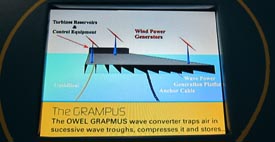 [拡大画像: x25894.jpg]
[拡大画像: x25894.jpg]
・ 「グランパス Grampus 」: 「オーウェル・グランパス OWEL GRAMPUS」の波力変換器は絶え間なくやって来る
波の谷において空気をトラップし、それを圧縮し、その圧縮された空気を蓄える。
・ システムは海洋の適所に曳航され係留される。
・ スコットランドのオークニーにて外洋向けのプラットフォームを建設し試験する計画がある。
The Grampus
> The OWEL GRAMPUS wave converter traps air in sucessive wave troughs, compresses it and stores it in a compressed
air reservoir. image caption/terms: turbines reservoirs and control equipment, wind power generators, wave power
generation flatform, anchor cable, umbilical.
> The system is towed and moored to a suitable site in the ocean.
> It is planned to construct and test a sea-going platform in Orkney, Scotland.
[画像撮影 2013.5.29 英国・プリモス国立海洋水族館]
1.[拡大画像: x25817.jpg] 2.[拡大画像: x25692.jpg] 3.[拡大画像: x25693.jpg]
* パネル全体 [拡大画像: x25820.jpg]
9. 波力発電における電気集積のための海底ハブシステム
 拡大画像
拡大画像
英国の港町プリモスは、英国南西部のコーンウォル半島にあって、イギリス海峡の西側海域に面する。プリモスはかつて数多く
の歴史的航海の起点となった港町でもある。そのプリモスの国立海洋水族館
National Marine Aquriumにおいて、海洋エネルギー発電に関して大変分かりやすいパネル展示がなされていた。
画像は、洋上に設置された各種の波力発電装置から電気を集積し、陸上のグリッド (高圧送電線網) に送電するための海底設置
ハブシステムを模式図にしたものである。説明パネルには次のように記されている。
発電した電気をすべてプラグで接続する
・ 海洋発電装置はしばしば何キロも沖合いに、あるいは遠隔地にある海岸線沿いに設置される必要がある。
・ これらのサイトは電力の需要地から遠く離れているものである。
・ この電力を全て集積し、それを国の電力グリッドに接続することは問題を起こしかねない。
・ 海洋発電装置による電気の発電は、風、波浪、潮汐の状態によって変動を受けやすい。
・ 再生可能なこれらの新しいエネルギー源によって産み出されるさまざまな電気出力に対応するためには、国の電力グリッド
も改善されて行く必要があろう。
Plugging it all together
> Ocean power devices often need to be installed many kilometres out to sea or on remote shorelines.
> These sites can be a long way from where the power is needed.
> Collecting all this power and plugging it into the national electricity grid can be a problem.
> Electricity generation from ocean power devices is variable as it depends on the state of the wind, waves and tides.
> The national electricity grid will also need improving to cope with the different outputs of these new sources
of renewable energy.
[拡大画像: x25868.jpg: 「Plugging it all together」]
事例研究: 「ウェーブハブ WaveHub 」
・ 「ウェーブハブ」は、海底に設置される巨大な電気ソケットのようなものである。
・ 「ウェーブハブ」は、遠隔地にある種々の海洋発電装置によって発電された電気をすべて集め、この電力をシングル・
ケーブルでもって国のグリッドに送電することができる。
・ 研究によって「ウェーブハブ」が作動することが示されれば、コーンウォルの北岸沖16㎞のところであらゆる試験がなされる
ことになろう。
Case Study: WaveHub
> Wave Hub is like a giant electrical socket located on the seabed.
> It can collect all the electricity generated from many different remote occean power devices and feed this power
into the narional grid with a single cable.
> If studies show that Wave Hub can work, it will be fully tested 16 km off the north coast of Cornwall.
[拡大画像: x25869.jpg: 「Case Study: WaveHub」]
「ウェーブハブ」
・ 「ウェーブハブ」は、波力エネルギー変換器の列群を繋ぐための海底の電気「ソケット」といえる。
・ 特に、「ペラミス」のような波力エネルギー変換器は、「ウェーブハブ」に連結されることになろう。
・ 翻って、その「ウェットハブ」は配電ユニットに、そして「ウェーブハブ変電所」に連結され、その後家庭に電気を送電する
ユーティリティ会社(公益事業体)の変電所に連結されることになろう。
WaveHub
> Wave Hub will be a sub-sea electrical 'socket' to connet arrays of wave energy converters.
> Among others, wave energy converters such as 'Pelamis' would be connected to the Wave Hub.
> In turn the 'Wet Hub' would be connected to a distribution unit, and Wave Hub substation...
...and then to the utility company substation delivering electricity into our homes.
「ウェーブブイ」
・ 「ウェーブブイ」は計画中の「ウェーブハブサイト」において波力エネルギー環境に関するデータを集める。
・ 最初の原子力「ジュース」グリーンエネルギー助成金によって出資され、2005年1月に着手され、、、、「ウェーブブイ」
からのデータは波力エネルギー開発者に利用されることになろう。
Wave Buoy
> Wave buoy collects data on the wave energy climate at the proposed Wave Hub Site.
> Launched in January 2005 and funded by the first npower Juice green energy grant...
...data from Wave Buoy will be made available to wave energy developers.
[画像撮影 2013.5.29/英国・プリモス国立海洋水族館][拡大画像: x25867.jpg][拡大画像: x25866.jpg]

* 「ウェーブハブ」の説明は中央のパネルにある。 [拡大画像: x25852.jpg]
10. 海岸固定式波力発電装置「リンペット」
Wave Power Generation Devices Fixed in Harbour Walls and Breakwaters
1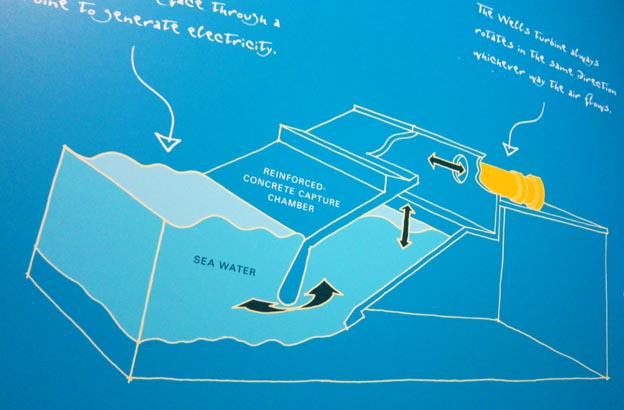 500 拡大画像
2
500 拡大画像
2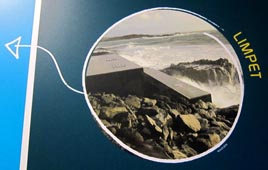
英国の港町プリモスは、英国南西部のコーンウォル半島にあって、イギリス海峡の西側海域に面する。プリモスはかつて
数多くの歴史的航海の起点となった港町でもある。そのプリモスの国立
海洋水族館において、海洋エネルギー発電に関して大変分かりやすいパネル展示がなされていた。
画像は、海岸の岩場に設置された強化コンクリート室(チャンバー)内に空気を閉じ込め、その圧縮空気圧を利用して
タービンを回転させ発電するという波力発電装置「リンペット」の模式図である。説明パネルには次のように記されている。
Fixed devices 固定式装置
・ 「リンペット」は港にある壁や防波堤に設置する設計になっている。
・ 強化コンクリートチャンバー(室)にトラップされる (閉じ込められる) 空気を利用する。
・ 波がチャンバーに打ちつけるたびにトラップされる空気がタービンへと導かれ電気を起こす。
> LIMPET is designed for intallation in harbour walls and breakwaters.
> It makes use of air trapped in a reinforced-concrete chamber.
> As waves hit the chamber the trapped air is forced through a turbine to generate electricity.
Wave energy technology 波力エネルギー技術
・ 海の波のもつエネルギーをつかまえるためには、波が通過する道に、そのエネルギーのいくらかを取り出すための何かを
設置せねばならない。
・ 波力発電装置は、それがうまく作動するものならば、しばしば大規模なものである必要がある。
・ ほとんどの波力エネルギー実験は水槽内で小規模な模型を使って行われてきた。
> To capture energy from ocean waves you must put something in the path of the waves that takes out some of that energy.
> Wave energy devices often need to be very large if they are to work well.
> Most wave energy experiments have been carried out using small-scale models in tanks.
模式図/キャプション
(右) 「ウェルズ」タービン (Wells turbine) は、空気がどちらの方向に流れようとも、いつも同じ方向に回転する。
(左) 「ウェルズ」タービンについては、波の上下動につれて空気が前後方向に動く「リンペット」のような固定式波力発電装置においての
利用が理想的である。
> The Wells turbine always rotates in the same direction whichever way the air flows.
> It is ideal for use in fixed wave power devices such as LIMPET where air moves backwards and forwards
as the waves rise and fall.
(下) 波の上下動によって、岩場面に設置される強化コンクリート室(reinforced concrete capture chamber)にトラップされる
空気をタービンに送り込んで電気を起こす。
「ウェルズ」タービンは空気がどちらの方向に流れようともいつも同じ方向に回転する。
> The rise and fall of the waves forces air trapped in the reinforced-concrete chamber set into the rock face through
a turbine to generate electricity.
> The Wells turbine always rotates in the same direction whichever way the air flows.
1 2
2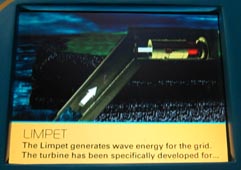 3
3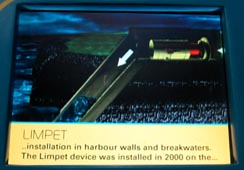
1. [拡大画像: x25896.jpg]
2. [拡大画像: x25897.jpg]
3. [拡大画像: x25898.jpg]
* LIMPET: 「ウェーブゲン Wavegen」は世界初の商業的規模での波力エネルギー装置「リンペット」を開発し、営業している。
* 「リンペット」はグリッド(高圧送電線網)向けに波力エネルギーをもって発電している。そのタービンは、港内の壁や防波堤
に設置できるよう特別に開発されてきた。「リンペット」装置はスコットランドのアイレー (Islay) 島*に2000年に
設置された。「リンペット」は "oscillating water column" の原理を利用している。
* アイレー島: スコットランド西岸沖のインナー・ヘブリディーズ諸島 (Inner Hebrides) の最南端の島
> Wavegen developed and operates Limpet, the world's first commercial-scale wave energy device.
> The Limpet generates wave energy for the grid. The turbine has been specifically developed for....
...installation in harbour walls and breakwaters. The Limpet device was installed in 2000 on the ....
...island of Islay in Scotland. The Limpet uses the principle of an oscillating water column.
[2013.05.29 画像撮影: 英国・プリモス国立海洋水族館にて]
1. [拡大画像: x25875.jpg][拡大画像: x25813.jpg]
2. [拡大画像: x25874.jpg][拡大画像: x25814.jpg]
 [拡大画像: x25818.jpg][画像: z19796.jpg]
[拡大画像: x25818.jpg][画像: z19796.jpg]
11. 波力利用揚水装置⌈アクアブイ⌋&発電
wave-driven pumping device AquaBuoy and power generation
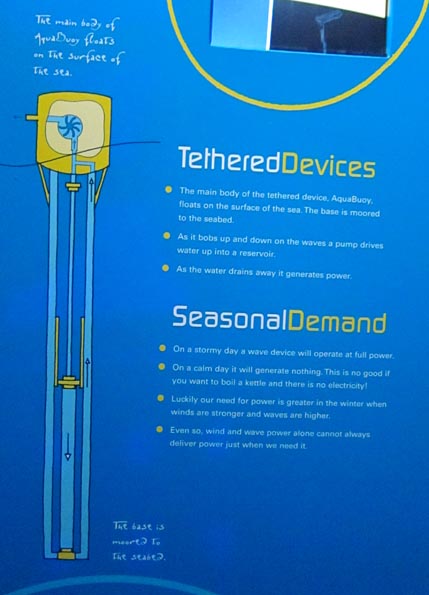 拡大画像
拡大画像
英国の港町プリモスは、英国南西部のコーンウォル半島にあって、イギリス海峡の西側海域に面する。プリモスはかつて数多く
の歴史的航海の起点となった港町でもある。そのプリモスの国立海洋
水族館において、海洋エネルギー発電に関して大変分かりやすいパネル展示がなされていた。
画像は波の上下動によって海水を揚水する装置⌈アクアブイ AquaBuoy⌋の模式図である。装置によって揚水され
貯水された海水を利用して発電するユニークな発想の海洋エネルギー変換装置である。説明パネルには次のように記される。
海底につながれた装置
・ ⌈アクアブイ⌋と名付けられる、索で繫がれた装置⌈アクアブイ⌋の本体は海面に浮かんでいる。
そのベース(基部)は海底に繫ぎ止められている。
・ 波によって上下するにつれ、ポンプは海水を貯水池へと揚水する。
・ その海水が排水される時に発電する。
季節的な需要
・ 荒れた日には、波力装置というものはフルパワーで作動する。
・ 穏やかな日には、何の発電もしない。湯を沸かしたい時に電気が無いというのでは宜しくない。
・ 我々の電力需要は、幸いにも、風がより強く波がより高くなる冬場においてより大きくなる。
・ そうであるとしても、風力と波力というものは、我々が電力を必要とする時にいつも供給しうるとは限らない。
Seasonal demand
> On a stormy day a wave device will operate at full power.
> On a calm day it will generate nothing. This is no good if you want to boil a kettle and there is no electricity!
> Luckily our need for power is greater in the winter when winds are stronger and waves are higher.
> Even so, wind and wave power alone cannot always deliver power just when we need it.
[画像撮影 2013.5.29 英国・プリモス国立海洋水族館][拡大画像: x25879.jpg]
12. 波のエネルギー&波力について Wave Energy and Power
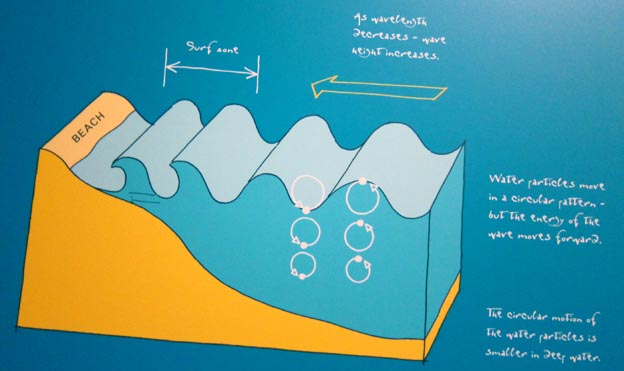 拡大画像
拡大画像
* 画像のキャプション: 波長が短くなるつれ、波高は高くなっていく。水の粒子は円を描くパターンで動くが、その波の
エネルギーは前方向に伝わって行く。水粒子の円運動は深いところではより小さい。
> As wavelength decreases - wave height increases. Water particles move in a circular pattern - but the energy of
the wave moves forward. The circular motion of the water particles is smaller in deep water.
なお、波は浅水域を経て海岸へ打ち寄せられ砕ける(破砕する)。この現象が起こるところをサーフ・ゾーン(砕波帯・はさいたい、
surf zone)という。
|
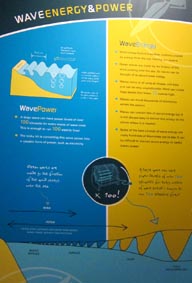 英国の港町プリモスは、英国南西部のコーンウォル半島にあって、イギリス海峡の西側海域に面する。プリモスはかつて
数多くの歴史的航海の起点となった港町でもある。そのプリモスの国立海洋水族館において、
海洋エネルギー発電に関して大変分かりやすいパネル展示がなされていた。 [拡大画像: x25821.jpg]
英国の港町プリモスは、英国南西部のコーンウォル半島にあって、イギリス海峡の西側海域に面する。プリモスはかつて
数多くの歴史的航海の起点となった港町でもある。そのプリモスの国立海洋水族館において、
海洋エネルギー発電に関して大変分かりやすいパネル展示がなされていた。 [拡大画像: x25821.jpg]
画像は、風によって引き起こされた波が沿岸に接近する時の、海中における水粒子(particles)の動きを説明する模式図である。
説明パネルには次のように記される。
波のエネルギー
・ 風は、海を温めている太陽からのエネルギーが作りだす気候システムによって引き起こされる。
・ 海の波は、海上を吹き抜ける風の摩擦によって生じる。故に、波は蓄えられた太陽エネルギーと考えられる。
・ 波はあらゆる形状とサイズでやって来るので、大変予測することが困難である。風は高さ15メートルにもなる巨大な波を
生じさせることができる。
・ 波は大洋を横断して何千キロメートルも伝わって行く。
・ 波は莫大なエネルギーを含蓄するが、このエネルギーを必要とする場所に供することは必ずしも容易いとは限らない。
・ 波エネルギー源のベストなものの幾つかは、何百キロメートルもの沖合にある。海洋エネルギーを役立つ海洋パワーに変換する
のはなかなか難しいことでなのである。
Wave Energy
> Wind comes from the weather systems created by energy from the sun heating our oceans.
> Ocean waves are made by the friction of the wind passing over the sea. So waves can be thought of as
stored solar energy.
> Waves come in all sorts of shapes and sizes and can be very unpredictable.
Wind can create huge waves that tower 15 metres high.
> Waves can travel thousands of kilometres across the oceans.
> Waves can contain lots of stored energy but it is not always easy to deliver this energy
to the places where it is needed.
> Some of the best sources of wave energy are many hundreds of kilometres out to sea.
It can be difficult to convert ocean energy to useful ocean power.
[拡大画像: x25876.jpg: Wave Energy]
波のパワー
・ 大きな波は、波峰1メートルごとに100キロワット以上の電力レベルをもつことができる。これは100台の電気ヒーターを
使うのに十分なものである。
・ 少々やっかいなのは、この波力を電気のような利用可能なパワーの形に変換することである。
Wave Power
> A large wave can have power levels of over 100 kilowatts for every metre of wave crest.
This is enough to run 100 electric fires!
> The tricky bit is converting this wave power into a useable form of power, such as electricity.
[拡大画像: x25877.jpg: Wave Power]
* キャプション
・ 「フェッチ(fetch)」とは風成の波(風によって引き起こされる波)が障害物なく伝わっていく吹送距離のことである。
> Fetch is the distance over which wind-driven waves travel without obstructions.
micro ripples, ripples, chop fully developed sea [拡大画像: x25878.jpg: caption]
[画像撮影 2013.5.29 英国・プリモス国立海洋水族館][拡大画像: x25822.jpg]
13. 海流発電について
1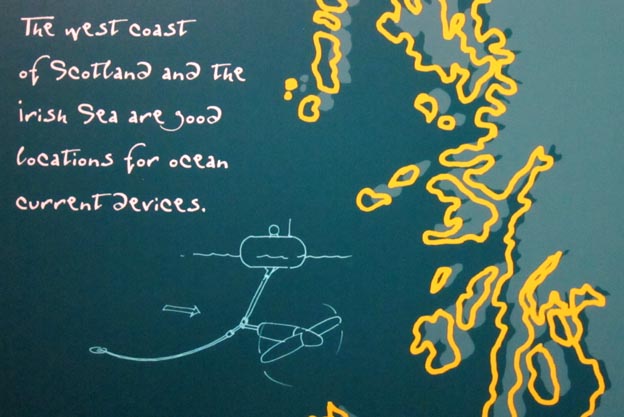
2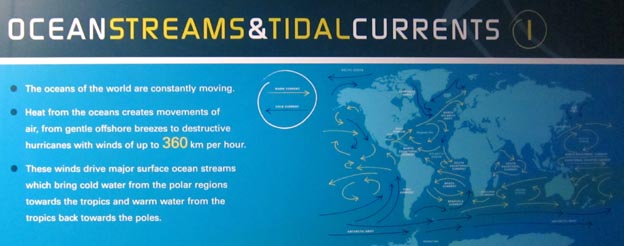
3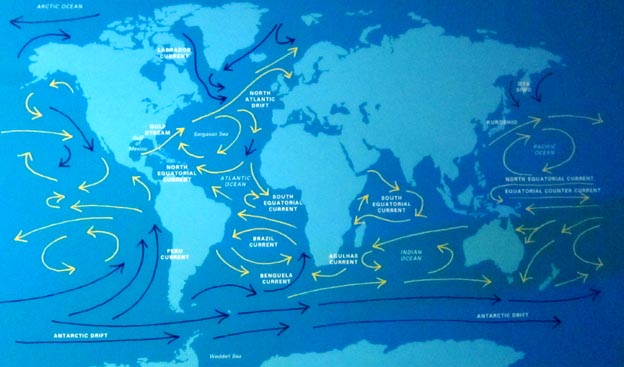
英国の港町プリモスは、英国南西部のコーンウォル半島にあって、イギリス海峡の西側海域に面する。プリモスはかつて
数多くの歴史的航海の起点となった港町でもある。そのプリモスの国立海洋
水族館 National Marine Aquriumにおいて、海洋エネルギー発電に関して大変分かりやすいパネル展示がなされていた。
画像は海流によって回転し発電する一つのローター式海流発電装置の模式図である。図のキャプションには、⌈スコット
ランドおよびアイリッシュ海の西岸は海流発電装置の良い立地場所である/The west coast of Scotland and the Irish Sea
are good locations for ocean current devices.⌋と記されている。
図によれば、海底のアンカリング装置から伸びる索で、大きなブイが洋上に繫ぎ止められている。その索の中位には大きな
ローター式発電装置が繋がれている。
⌈海流および潮流① & ② (Ocean Streams and Tidal Currents ① & ②に)⌋と題する展示パネル[拡大画像: x25881.jpg]には、
次のように記されている。
Ocean Streams and Tidal Currents ①
・ 世界の海はたえず動いている。
・ 海からの熱は、沖合におけるそよ吹く風から、時速360kmまでの風を伴う破壊的威力をもつハリケーンまで、空気の動きをつくる。
・ これらの風は大きな表層海流を押し流す。そして、極地方から熱帯地方に向けて冷たい海水を、熱帯地方から極に向けて
暖かい海水をもたらす。
> The oceans of the world are constantly moving.
> Heat from the oceans creates movements of air, from gentle offshore breezes to destructive hurricanes
with winds of up to 360 km per hour.
> These winds drive major surface ocean streams which bring cold water from the polar regions
towards the tropics and warm water from the tropics back towards the poles.
[画像撮影 2013.5.29 英国・プリモス国立海洋水族館]
1. 海流発電模式図。 [拡大画像: x25815.jpg]
2. ⌈海流および潮流①⌋。 [拡大画像: x25811.jpg]
3. 世界の海流図。 [拡大画像: x25812.jpg][画像:z19834.jpg][拡大画像: x25886.jpg]
14. 洋上風力発電
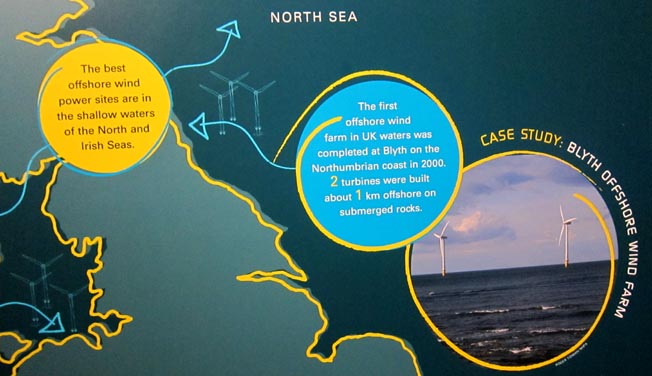
英国の港町プリモスは、英国南西部のコーンウォル半島にあって、イギリス海峡の西側海域に面する。プリモスはかつて
数多くの歴史的航海の起点となった港町でもある。そのプリモスの国立海洋水族館において、海洋エネルギー
発電に関して大変分かりやすいパネル展示がなされていた。
画像は、英国沿岸で構想されてきた海流、潮汐・潮流利用発電などに加えて、洋上風力発電ファームの実例を示す同国周辺海域
利用図の一部である。説明パネルには次のように記されている。
英国の海洋パワー
ファクト・フォーカス
・ 波力、風力、潮汐発電に最も適した立地のいくつかは、世界でもこの英国周辺に見出される。
・ 風の速さは陸上におけるよりも海上の方がより高いので、風力タービンを沖に設置する理想的な場所は海洋である。
また、海洋は規模がより大きくてより費用対効果がある風力ファームを建設するにはより容易である。
・ 30km×40㎞の巨大な沖合ウインドファームは、理論的には英国の電力需要の10%を供給することができよう。
UK Ocean Power
Fact Focus
> Some of the best locations in the world for wave, wind and tidal power are found around the UK.
> The ocean is an ideal place to put offshore wind turbines as wind speeds are higher at sea
than on land. It is also easier to build larger and more cost effective wind farms.
> A giant offshore wind farm 30km by 40km could theoretically supply 10% of UK electricity.
* 波力関連
・ 科学者は、英国の北および西の海岸線沿いでの平均的な波力発電総量を年間260テラワット時に匹敵すると推定している。
英国の2002年における電力需要は350テラワット時であった。
> Scientist estimate that the total average wave power along the west and north shoreline of the UK is equal to 260
TWh per year.
The UK electricity demand in 2002 was 350 TWh.
* 風力関連
・ 沖合風力発電のベスト・サイトは、北海およびアイリッシュ海の浅海域にある。
> The best offshore wind power sites are in the shallow waters of the North and Irish Seas.
* 事例研究: ブライス沖合ウインドファーム
・ 英国水域での最初の風力ファームは、2000年にノースハンブリアン沿岸にあるブライスで完成された。
2基のタービンが沖合 1 kmの暗礁の上に設置された。
[注]ブライス: スコットランドのニューキャッスル (北海に面する) 北東に位置する沿岸都市.
Case Study: Blyth Offshore Wind Farm
> The first offshore wind farm in UK waters was completed at Blyth on the Northhumbrian coast in 2000.
2 turbines were built about 1 km offshore on submerged rocks.
* 風力ファーム関連
・ ノース・ホイル沖合ウインドファームは、北ウェールズの海岸沖8㎞に立地する。それぞれ2MWの定格をもつ30基の
タービンが、2003年11月に稼働した。ウインドファームは5万世帯用に十分な電気を発電することができるはずである。
> North Hoyle offshore wind farm is located 8 km off the coast of North Wales. リバプールの近くか
The 30 turbines, each rated at 2 MW, were switched on in November 2003. The wind farm should be able to generate enough
electricity for 50,000 UK homes.
* バラージ潮汐ダムサイト関連
・ セヴァーンのような大きな河口域はバラージ式 (築堤・築堰式) 潮汐や潮流発電装置を設置するにはベストなサイトである。
[注]セヴァーン (Severn) : 英国南西部のコーンウォル半島とウェールズとの間にはさまれたブリストル水道 (Bristol Channel) の湾奥域。
ウェールズを流れ下るセヴァーン河の河口域のこと。下流地方には大都市ブリストル (Bristol) がある。
> Large estuaries, such as the Severn, make the best sites for tidal barrages and tidal current devices.
・ 漁業者は沖合ウインドファーム周辺海域での魚資源が増加したと報告してきた。それらファームは人工漁礁のような役割を
果たしており、海の生き物を促進することができる。
> Fishermen have reported increased fish stocks around offshore wind farms. They can act like artificial reefs and
encourage sea life.
・ 英国のベストな波力場所のいくつかはスコットランドにある。
> Some of the best UK wave power locations are in Scotland.
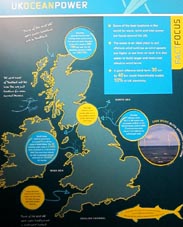
「英国海洋パワー(UK ocean power)」と題する英国周辺海域利用図。 [画像: z19829.jpg][拡大画像: x25887.jpg][拡大画像: x25880.jpg]
[画像撮影 2013.5.29/英国・プリモス国立海洋水族館][拡大画像: x25893.jpg]
 このページのトップに戻る
/Back to the Pagetop
このページのトップに戻る
/Back to the Pagetop